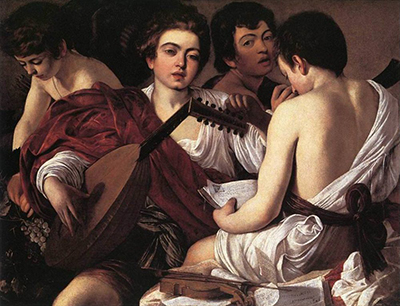The Musicians was executed in oil in 1597 for Cardinal Francesco del Monte, his first patron, who was an intellectual and a significant figure in the arts.
The Cardinal arranged musical events, and invited musicians and artists to share his home, during a period when tastes in music and form were changing within the Church.
Thought to be Caravaggio's first picture for del Monte, The Musicians lacks the full fluidity of later work, probably due to inexperience, experimentation, and subjects being added at different times.
Nevertheless, the closeness of the group to the viewer brings immediacy and intimacy to this allegory, conveying the pain of love and the emotion of music. Even at this time, the artist's use of light and colour complemented his naturalistic style.
The youths are rehearsing with contemporary instruments, but Caravaggio mixes life and canvas with clothing that seems classical. While the lute player tunes up, Cupid reaches for some grapes on the left, emphasising the link between love and music, and how it is heightened by wine.
The horn player in the middle, thought to be a self-portrait, stares directly out of the canvas, while the fourth participant checks the music score of the madrigals that are the subject of the artwork. The remaining three are probably portraits of other household members, with the sad lutist believed to be painter and fellow resident Mario Minniti. In addition, the violin in the foreground hints at a fifth player not shown.
Although revered and well documented at the time, the work disappeared and searches were unsuccessful. It wasn't until the twentieth century that a dealer acquired it from a country house sale, eventually selling it to a client for a low price. The Musicians now hangs in New York's Metropolitan Museum, although its condition is understandably not perfect.
Caravaggio died in 1610 at Porto Ercole, Tuscany, in tragic circumstances while returning from a period of banishment after committing murder. It is possible that his turbulent life and volatile temperament have been exaggerated, or that at least he was merely a product of his times, and of an unstable childhood.
It is certainly hard to believe that someone who brought such intense realism to his religious subjects, and who developed his own interpretation of chiaroscuro with extremes of light and dark, was merely a troublemaker with no sensitivity.
His canvases are filled with the faces of ordinary people from the streets, providing art lovers today with a glimpse of real life in seventeenth-century Italy. Today, his influence extends beyond painters to film directors such as Martin Scorsese and Pier Paolo Pasolini, and it's not hard to see The Musicians as a still from a film.




